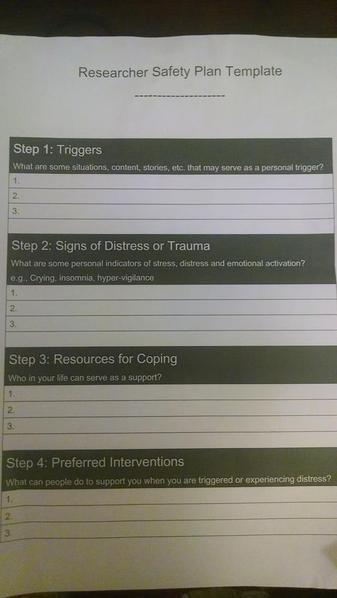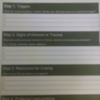I just returned from the 10th Biennial Conference of the Society for the Psychological Study of Social Issues (aka SPSSI, APA Division 9) in Portland, OR. Although I was there in my capacity as a graduate student and as the chair-elect of SPSSI’S Graduate Student Committee, I couldn’t help but notice the many presentations and references to trauma and the type of work done by members of ACEs Connection.
In the four days of conference and pre-conference activities, I was introduced to a number of Portland organizations working to reduce the consequences of trauma, including p:ear, an organization that provides mentoring, love, and support to homeless youth, and Adelante Mujeres, which includes ESPERE, a workshop that helps women understand how their trauma has affected them and helps guide them towards healthy, violence-free relationships. I recommend checking out the work of both organizations.
However, there was one session that was particularly useful to researchers working with individuals who have experienced trauma. This was an interactive discussion entitled “Addressing Secondary and Vicarious Trauma Among Social Science Researchers.” Lead by Melissa Bayne, an adjunct faculty member at California State University, Sacramento, and Thomas Sterling, a licensed clinical social worker, the discussion walked participants through why social justice research is stressful, the basics of the ACE Study and toxic stress, and methods for reducing stress. Here is the shortened version of what we learned:
- Emergency room workers and clinical psychologists are more prepared to deal with vicarious and secondary trauma than are researchers. However, burnout rates are high for people studying social justice issues.
- Over years of hearing many upsetting stories about trauma, researchers can accumulate trauma of their own.
- Our ability to cope is affected by both our personal resources and our previous experiences. This means we can all handle exposure to different things in different amounts. Despite this, there are still expectations that researchers should be able to handle the trauma to which they are exposed.
- People are often attracted to this research because of their own experiences, so this adds to the cumulative trauma.
- Secondary trauma vs. vicarious trauma
- Vicarious trauma: Empathetic reactions lead us to “take on” the experiences of other people. This can lead to symptoms similar to those experience by individuals who experience the trauma first hand—depression, anxiety, sleep difficulties, panic attacks, and avoidance of exposure to trauma (including simply avoiding talking about the trauma or watching trauma on television).
- Secondary trauma: Compassion fatigue. While a research may begin studying a topic with optimism, hoping that they can create change through increased understanding, this drive to help can change with repeated exposure to trauma.
- An example of vicarious trauma: In addition to her university work, Dr. Bayne works with a violence intervention center. Although she lives in a generally safe area, she is now hypersensitive to certain stimuli in her neighborhood, like slow driving cars, because she associates them with gang activity that she hears about in her work. She now will sit in the rooms in the back of her apartment to avoid these stimuli.
- What researchers can do about secondary and vicarious trauma:
- Breathing activities: Dr. Bayne walked us through a breathing exercise that can be done to reduce anxiety while you are in the field and can help return you to a sense of calm. Called “4 by 4 Breathing,” you breathe in for a count of four, hold for a count of four, breathe out for a count of four, hold for four, and repeat. Through “faking” calm with this exercise, you can ultimately actually calm yourself.
- Safety planning: Safety planning was originally designed for suicidal clients, but can also be useful for researchers exposed to trauma. The discussion leaders suggest that through this exercise researchers can share their “triggers” with lab-mates and co-workers, so that they can help you when you are faced with trauma. Safety planning for researchers consists of 1) identifying situations that serve as triggers, 2) indicating signals of being triggered, 3) identifying resources for coping, and 4) suggesting ways that people around them can help them cope. Here’s an example: 1) child victims are a trigger for Jen because she has young children, 2) when Jen is upset she retreats into her office, 3) Jen trusts her co-worker Tom, so Tome should come talk to Jen, rather than other people in her office, and 4) Tom insists Jen take the afternoon off to play tennis, because he knows this reduces her stress. The attached document provides a blank handout for you to create a safety plan with your own lab-mates or co-workers.
- “The Nexus Ball”: This game facilitates closeness between lab-mates or co-workers who can provide one another with support. One individual holds a ball and prepares to share a piece of good or bad news. However, first they tell the group members how they would like them to respond to the news. (For example for good news you may ask them to put their hands in the air and shout “Yay!”. For bad news you may ask people to respond by shaking a first and saying, “drat.” You then share your piece of good or bad news, and everyone responds according to your request. Sharing good news allows you to celebrate together and sharing bad news allows you to dispel the weight of the news or normalize it and tells other people in the group that you are someone they could talk to if they are dealing with a similar problem. The ball is then passed around to those who wish to share news (not everyone needs to participate).
- Playing: The discussants suggested play as a way to reduce one’s stress. Find an activity you enjoy or find a short game to play with your lab-mates/co-workers.
Overall, the session and the conference overall provided a lot of food for thought and helpful information and techniques. I hope you also find it interesting/helpful!





Comments (1)